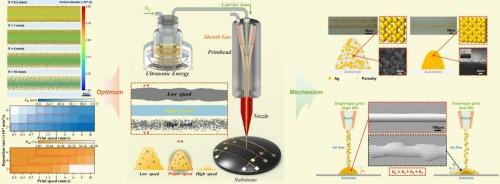通过优化不同沉积速率下的打印速度范围,提高了气溶胶喷射打印的形貌和电导率
IF 7.9
2区 材料科学
Q1 MATERIALS SCIENCE, MULTIDISCIPLINARY
引用次数: 0
摘要
气溶胶喷射(AJ)打印由于其非接触能力,在印刷共形电子产品中变得越来越有吸引力。然而,沉积速率和打印速度对打印痕迹形貌和电学性能的影响尚不清楚。本研究在常用的沉积速率值(0.0002、0.0004和0.0006 mm3/s)下,对不同打印速度(0.3 ~ 20 mm/s)的AJ打印痕迹进行了检测。通过对打印痕迹的形貌和电导率进行评价,确定了各沉积速率下的最佳打印速度范围:沉积速率为0.0002 mm3/s为0.3 ~ 1.5 mm/s,沉积速率为0.0004 mm3/s为0.7 ~ 4 mm/s,沉积速率为0.0006 mm3/s为1 ~ 6 mm/s。建立了三维计算流体动力学(CFD)模型,分析了不同沉积速率下AJ打印痕迹的基本气动特性,其变化趋势与实验观察结果一致。分析了打印速度影响电导率的机理,发现在低打印速度下,内部孔隙度是降低电导率的主要因素。通过对不同打印模式下的形貌、电导率和打印效率的分析发现,在不同的沉积速率和打印速度组合下,单层打印时的打印痕迹形貌保持一致。值得注意的是,在高沉积速率和高打印速度下,打印效率大大提高。与低沉积速率的多层印刷相比,高沉积速率的单层印刷成为获得更高效率和导电性的最佳方法。最终,在电阻、打印速度和沉积速率之间建立了相关性,从而能够成功打印15个具有特定电阻值的电阻(20 Ω),用于不同的几何形状,平均误差为5.9%,从而扩大了AJ打印在印刷电子产品中的适用性。本文章由计算机程序翻译,如有差异,请以英文原文为准。

Enhanced morphology and conductivity in aerosol jet printing via optimization of print speed range under various deposition rate
Aerosol Jet (AJ) printing is becoming increasingly attractive for printed conformal electronics due to its non-contact capability. However, the impact of deposition rate and print speed on the morphology and electrical properties of printed traces remains unclear. In this study, AJ printed traces with different print speed (0.3–20 mm/s) under commonly used deposition rate values (0.0002, 0.0004 and 0.0006 mm3/s) were examined. After evaluating the corresponding morphology and conductivity of the printed traces, the optimal print speed range of each deposition rate was determined as follows: deposition rate of 0.0002 mm3/s as 0.3–1.5 mm/s, 0.0004 mm3/s as 0.7–4 mm/s, and 0.0006 mm3/s as 1–6 mm/s, respectively. A three-dimensional computational fluid dynamics (CFD) model is proposed to elucidate the fundamental aerodynamic behaviors of AJ printed traces under different deposition rate, and its trends align with experimental observations. The mechanism by which print speed influences conductivity was analyzed, revealing that internal porosity is the primary factor reducing conductivity at low print speed. The analysis of morphology, conductivity, and printing efficiency across various print modes revealed that the morphology of printed traces under the respective deposition rate and print speed combination remained consistent in single-layer printing. Notably, printing efficiency is substantially enhanced at elevated deposition rate and high print speed. Compared to multi-layer printing at low deposition rate, high deposition rate single-layer printing emerges as the optimal method for achieving superior efficiency and conductivity. Ultimately, a correlation was established between resistance, print speed, and deposition rate, that enabling the successful printing of 15 resistors with specific resistance values (20 Ω) for different geometries, within an average error of 5.9 %, thereby broadening the applicability of AJ printing in printed electronics.
求助全文
通过发布文献求助,成功后即可免费获取论文全文。
去求助
来源期刊

Materials & Design
Engineering-Mechanical Engineering
CiteScore
14.30
自引率
7.10%
发文量
1028
审稿时长
85 days
期刊介绍:
Materials and Design is a multi-disciplinary journal that publishes original research reports, review articles, and express communications. The journal focuses on studying the structure and properties of inorganic and organic materials, advancements in synthesis, processing, characterization, and testing, the design of materials and engineering systems, and their applications in technology. It aims to bring together various aspects of materials science, engineering, physics, and chemistry.
The journal explores themes ranging from materials to design and aims to reveal the connections between natural and artificial materials, as well as experiment and modeling. Manuscripts submitted to Materials and Design should contain elements of discovery and surprise, as they often contribute new insights into the architecture and function of matter.
 求助内容:
求助内容: 应助结果提醒方式:
应助结果提醒方式:


